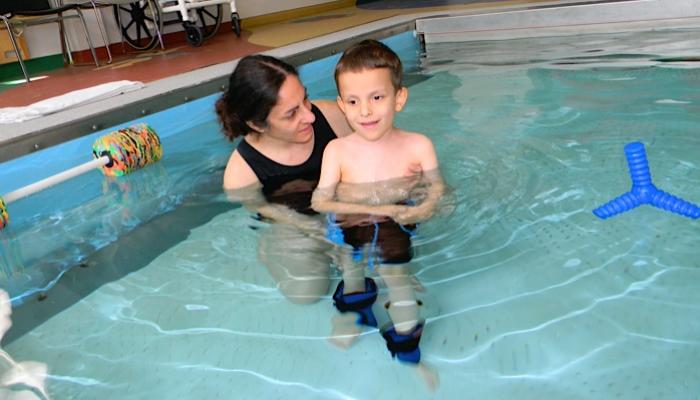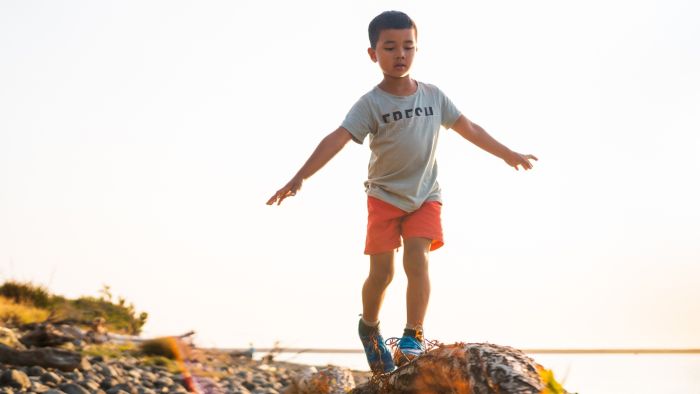What is Aquatic Therapy?

This post may contain affiliate links; please see our terms of use for details.
Aquatic therapy, or water therapy, is essentially physical, occupational, or recreation therapy that takes place in a heated pool.
You’ll often find aquatic therapy mentioned in connection with rehabilitation for people who have had strokes or have been in accidents. The low impact exercises done in the water can really help people who are trying to regain strength and flexibility.
But what about babies and children who have developmental delays?
Aquatherapy for children with disabilities, in addition to improving strength and flexibility, also focuses on body awareness, sensory integration, motor planning, and learning how to move muscles in new ways.
The pool is the perfect environment to learn these skills because it’s safe, makes movement easy, and it’s fun!
Why Water?
Water has always been considered healing or therapeutic and for good reason. Warm water can be relaxing and stimulating at the same time. It’s easier to learn to move in the non-restrictive environment of the water than it is on land, plus water therapy can be turned into a very playful time so that therapy doesn’t feel like therapy.
Here are some of the reasons why you might consider aquatherapy for your child:
- Exercises in the water are low impact. There is much less worry about stressing joints or muscles in the water. This can be a real plus for children with high muscle tone (hypertonia) who have difficulty moving.
- The warm water can also relax stiff muscles so kids can gain flexibility in the water they may not have on land.
- For kids and babies with low muscle tone (hypotonia), there is much less gravity in the water so it’s easier for them to move using less strength. They can be buoyed and supported by the water while they exercise.
- Blind babies often find it hard to process proprioceptive input. This means that they can find it difficult to understand where their body is or how it’s moving. This of course can make it difficult to learn how to move or to plan their own movements. Children and babies with proprioceptive difficulties may also find themselves kicking their legs or hitting themselves in inappropriate ways in an attempt to get that feedback that they are missing. The constant light pressure that surrounds the body in the water is the perfect antidote to this problem. Learning to move in the water is so much easier because you are much more aware of your body and your movements.
- Another problem common for kids with vision impairments is difficulty processing directional cues. Which way is up? Am I standing straight, or leaning to the side? The water with it’s constant push up is the perfect place to learn the concepts of up and down.
- Exercises in the water can be done in different positions comfortably and safely since you don’t have to worry about gravity or falling.
- Water provides a natural resistance that can increase muscle strength, but this resistance is proportional to the effort exerted against it, so the harder you push or kick, the more of a workout you get. If you can’t push as hard, you get a small work out. The water automatically adjusts to your child’s needs.
- There is very little gravity in the water, making it easier to focus on walking and kicking movements and honing balance and coordination, without having to worry about having the proper strength.
- The hydrostatic pressure in the water pushes evenly on all of the body at once. This helps the heart circulate blood and lowers blood pressure while in the water. This can also help relax the body and reduce stress.
What Aquatherapy Looks Like
You may be wondering what aquatherapy looks like when implemented. I have two videos below that demonstrate just how much of a difference the water can really make.
In the first video you’ll see Ivan in his gait trainer on land with his physical therapist. They are working on taking steps independently. You can see that he is motivated, but the movements and coordination are very difficult for him.
In the second video Ivan is working on the same skill, but in the water. Here he needs very little support at the waist and is able to take nice big steps by himself. He lifts his feet, bends his knees, and walks with much more ease. Also notice that Ivan is wearing ankle weights. This helps ground him and keeps his legs from floating about too much.
What You Can Do in the Water
There are many activities you can play with your child while swimming in the pool or even while taking a bath that can stimulate development. Here are a few of our favorite water games:
- Rocket Ship: Have your child lie on his back in the water and place his feet on the wall of the pool or bath tub. Encourage him to kick off the wall so he can get some momentum in the water. We like to count down “5, 4, 3, 2, 1… blast off!” like a rocket ship. The movement feels great plus it’s a good leg exercise. If you’re in the pool, try this game while your child wears a swim belt so they can really float. We like the AquaJogger Jr. Belt, but you can also try the Schlori Swim Cushions or the WaterWayBabies Float.
 Kicking: Simply kicking in the water is a fantastic exercise. It’s also a lot of fun for babies and young children to create all that splashing and commotion all by themselves. See if you can get your child to do “quiet kicking” and “loud kicking.” Be prepared to get wet yourself!
Kicking: Simply kicking in the water is a fantastic exercise. It’s also a lot of fun for babies and young children to create all that splashing and commotion all by themselves. See if you can get your child to do “quiet kicking” and “loud kicking.” Be prepared to get wet yourself!- Cup Play: Stacking cups are a lot of fun in the water. We like to the cups with holes in the bottom, like The First Years’ Stack & Count Cups, so you can fill them up then feel the water tickle your skin as it drips from the holes. Turn the cups upside down and push them into the water and you’ll hear the water whistle and bubble through the holes.
- Sound Toys: We have a favorite water toy, the Boingo Ball, that makes a lot of sound in the water, floats, is water proof, and is easy to hold on to. We can throw this ball across the pool then splash and listen to locate it again. If you make even the slightest movement or ripple in the water, the Boingo Ball will make a nice distinct sound.
- Blowing Bubbles: Here’s another simple game that is fun and great developmentally. Encourage your child to blow bubbles or hum in the water. She’ll enjoy the sound and bubbles, plus she’s also strengthening her lungs and mouth. This is also an important first step in learning to hold your breath while swimming.
- Find the Duckies: Get yourself a set of rubber duckies and throw them all in the water. Have you child walk around the pool or spread his arms out in the bath and try to find as many of the duckies as possible. This is a great game that teaches searching techniques. We like water-tight rubber duckies, like the ones from Munchkin, because you don’t have to worry about mold or mildew growing inside them.
- Humpty Dumpty: Set your child on the wall of the pool and tell them they are Humpty Dumpty. Say the rhyme, “Humpty Dumpty sat on the wall, Humpty Dumpty had a great fall!” and help them splash back into the water. It’s fun and enhances protective techniques as your child puts his hands out to feel the water as he falls.
- This Way & That Way: Have your child lay on her back and hold her by her waist so that her head is out in the water. Gently sway her to the left and to the right. This helps stretch out her muscles and is a really fun sensation as well. We like to sing Did You Ever See a Lassie? while we do this one. This is another activity that works best with a Swim Belt.

Related Posts

Fine and Gross Motor
5 Alternatives to Tummy Time for Babies with Motor Development Challenges
Does your baby struggle with tummy time due to motor development challenges? These alternatives to tummy time will offer the same benefits.

Fine and Gross Motor
Understanding Hypotonia & Hypertonia: What Parents Need to Know
Altered muscle tone can affect your child’s development. Learn more about ways you can help your child by understanding hypertonia and hypotonia.

Fine and Gross Motor
4 Static Balance Activities for Kids
These four fun exercises will boost your child's static balance and coordination. They improve postural balance and strengthen core and glute muscles.